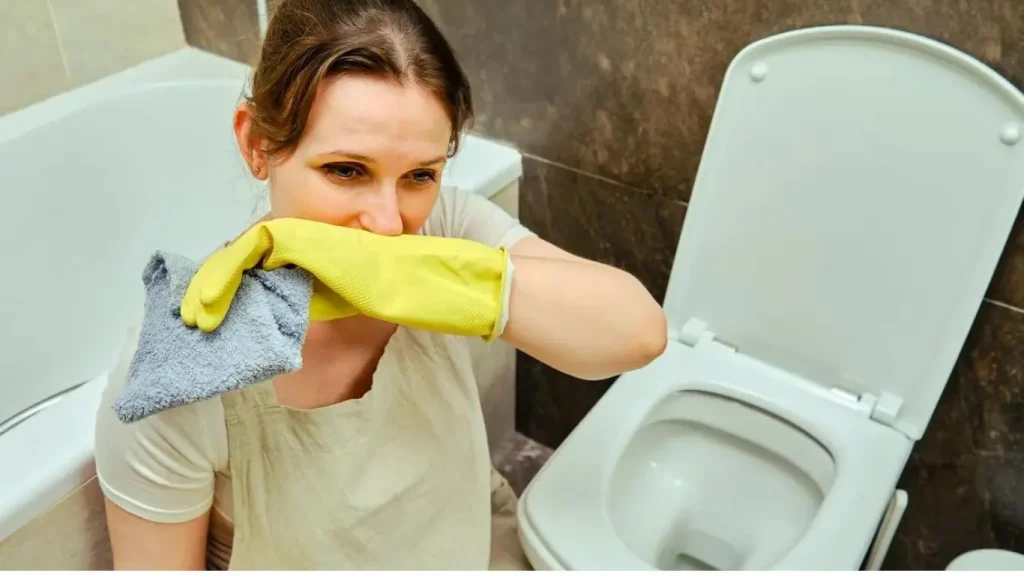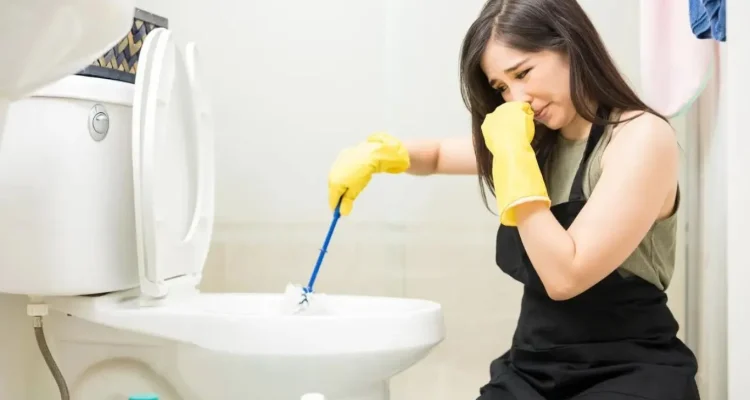Introduction
Unpleasant odors resembling sewage in your bathroom can indicate underlying issues within your plumbing system. Understanding these causes is crucial to effectively eliminating these odors and maintaining a fresh and clean bathroom environment.

Common Causes of Sewage Smell in the Bathroom
1. Dry P-Traps
What is a P-Trap and Why Does it Matter?
A P-trap is a U-shaped pipe located under sinks, showers, and other plumbing fixtures. Its purpose is to trap a small amount of water which prevents sewer gases from entering the living space. When a P-trap dries out, it loses its seal, allowing odors to permeate into the bathroom.
Symptoms of a Dry P-Trap
- Noticeable sewage odor from drains.
- Gurgling noises when water drains.
- Slow drainage or backups.
How to Fix a Dry P-Trap
To fix a dry P-trap, simply run water through the drain to refill the trap and restore the seal. Regularly using unused sinks and showers can prevent this issue.
2. Blocked Vent Pipes
Importance of Ventilation in Plumbing Systems
Vent pipes allow air into the plumbing system, enabling smooth drainage and preventing sewer gases from backing up into the home.
Signs of Blocked Vent Pipes
- Gurgling sounds in drains or toilets.
- Slow drainage.
- Sewage odors in the bathroom.
Clearing Blocked Vent Pipes
Clearing vent pipes often involves removing debris or obstructions using specialized tools. Professional plumbers can assess and clear more severe blockages.
3. Leaky Toilet Seal
Role of Toilet Seals in Odor Prevention
The toilet seal (wax ring) creates a watertight barrier between the toilet and the drain pipe, preventing water and odors from leaking out.
Indications of a Leaky Toilet Seal
- Persistent sewage smell around the toilet base.
- Water pooling around the toilet.
- Loose or shifting toilet.
Repairing a Leaky Toilet Seal
Replacing the wax ring involves removing the toilet, scraping off the old wax, placing a new wax ring, and reinstalling the toilet securely.
4. Clogged Drains
Impact of Clogged Drains on Odors
Clogged drains trap debris and organic matter, leading to bacterial growth and foul odors emanating from sinks, showers, or tubs.
Identifying a Clogged Drain
- Water pooling in sinks or showers.
- Slow drainage.
- Unpleasant smells from drains.
DIY Methods for Unclogging Drains
Home remedies like using a plunger, drain snake, or natural drain cleaners can effectively clear minor clogs. For persistent issues, professional drain cleaning may be necessary.
5. Sewer Line Issues
Overview of Sewer Line Problems
Issues such as tree root invasion, pipe corrosion, or blockages can lead to sewer gas backups and odors in the bathroom.
Symptoms of Sewer Line Issues
- Multiple drains clogging simultaneously.
- Sewage backups in toilets or drains.
- Foul odors outdoors near the sewer line.
Professional Solutions for Sewer Line Problems
Professional plumbers utilize advanced tools like sewer cameras to diagnose and repair sewer line issues efficiently. Solutions may include hydro-jetting, trenchless repairs, or pipe replacement.
6. Improper Bathroom Ventilation
Importance of Adequate Ventilation
Proper ventilation removes excess moisture from the bathroom, preventing mold growth and odors caused by stagnant air.
Signs of Poor Ventilation
- Condensation on windows or walls.
- Lingering odors after showers.
- Peeling paint or wallpaper.
Enhancing Bathroom Ventilation
Installing or upgrading exhaust fans, keeping windows open when possible, and using dehumidifiers can improve ventilation and reduce odors in the bathroom.
7. Biofilm Buildup
Understanding Biofilm in Plumbing
Biofilm is a slimy layer of bacteria that forms on wet surfaces in plumbing systems, contributing to foul odors and potential health risks.
Detecting Biofilm Presence
Slimy or discolored buildup around drains or faucets is indicative of biofilm presence. Unpleasant odors may also accompany biofilm growth.
Removing Biofilm Safely
Regular cleaning with antibacterial agents or using enzymatic cleaners can help break down biofilm and prevent its recurrence. Professional cleaning may be required for severe cases.
8. Old or Faulty Wax Ring
Role of Wax Rings in Toilet Installation
Wax rings create a waterproof seal between the toilet base and the drain opening, preventing leaks and odors.
Signs of Wax Ring Issues
- Water stains or damage around the toilet base.
- Unexplained sewage odors.
- Toilet wobbling or shifting.
Replacing a Wax Ring
Replacing a wax ring involves shutting off water, removing the toilet, scraping off the old wax, placing a new wax ring, and reinstalling the toilet securely to ensure a proper seal.
9. Sewer Gas Leak
Dangers of Sewer Gas Exposure
Sewer gases contain toxic components like methane and hydrogen sulfide, posing health risks such as respiratory issues and headaches upon exposure.
Detecting a Sewer Gas Leak
A strong rotten egg smell is a telltale sign of a sewer gas leak. Check for sewer gas concentrations using a gas detector for confirmation.
Immediate Actions for Sewer Gas Leaks
Upon detecting a sewer gas leak, ventilate the area immediately, evacuate if necessary, and contact a professional plumber to locate and repair the source promptly.
10. Mold and Mildew Growth
Conditions Favoring Mold and Mildew
Excess moisture from poor ventilation or leaks creates ideal conditions for mold and mildew growth in bathrooms.
Identifying Mold and Mildew in the Bathroom
Visible black spots or discoloration on walls, ceilings, or grout lines indicate mold and mildew presence. Musty odors may also accompany growth.
Mold Remediation Steps
Removing mold involves scrubbing affected surfaces with mold cleaner, ensuring proper ventilation during cleaning, and fixing underlying moisture issues to prevent recurrence.
Preventive Measures to Keep Your Bathroom Fresh
- Regular Maintenance
- Schedule annual plumbing inspections.
- Perform routine checks on P-traps, seals, and vents.
- Address minor issues promptly to prevent odors.
- Proper Ventilation
- Install exhaust fans in bathrooms without windows.
- Open windows or use fans during and after showers.
- Use a dehumidifier in humid climates.
- Prompt Repairs
- Fix leaks, replace damaged seals, and clear clogs immediately.
- Invest in professional plumbing repairs for complex issues.
- Follow manufacturer guidelines for toilet and plumbing maintenance.
FAQs About Why Does My Bathroom Smell Like Sewage?
Why does my bathroom smell like sewage after it rains?
- Rainwater can sometimes infiltrate sewer lines, causing backups and odors in bathrooms.
Can a dry P-trap cause sewage smells in my bathroom?
- Yes, a dry P-trap loses its water seal, allowing sewer gases to enter your bathroom.
How can I prevent my bathroom from smelling like sewage?
- Regularly run water in unused drains, fix leaks promptly, and ensure proper ventilation.
What should I do if I detect a sewer gas smell in my bathroom?
- Ventilate the area, check for dry P-traps or other issues, and contact a plumber if necessary.
Are sewage smells in the bathroom dangerous?
- Yes, sewer gases contain harmful components; prolonged exposure can lead to health issues.
Conclusion
By understanding and addressing the common causes of sewage smells in your bathroom promptly, you can ensure a clean, fresh-smelling environment and prevent potential health hazards associated with plumbing issues.


Congratulation!